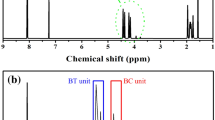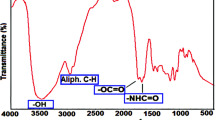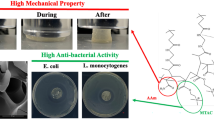Abstract
A biocomposite of poly(acrylamide-co-acrylic acid) hydrogel with β-cyclodextrin as a biomaterial was prepared through one-pot synthesis in water as a green solvent. The formation of biocomposite was confirmed by advanced techniques such as FTIR spectroscopy, XRD, DSC, TGA, and FE-SEM. In this report, straight forward and efficient synthetic protocol for biocomposite formation responded without any environmental hazard. Swelling capacity of P(AM-co-AA) and biocomposite was studied by addition of different saline solutions including monovalent, divalent, and trivalent salts. By addition of β-cyclodextrin, the swelling and saline water-absorbing properties of the biocomposite hydrogel were significantly improved. In this regard, the possible formation mechanism of the composite hydrogel is also discussed. It is deduced that the biocomposite formation can be the result of intermolecular interactions between polymer and β-cyclodextrin. The water-soluble polymer seems to have entered into the inner cavity of β-cyclodextrin to form supramolecular biocomposite structure. The results indicate that the order of water uptake decreases with increase in valency of the salts. It is believed that this is an effective method to prepare supramolecular biocomposite hydrogel materials. Its applications can be extended in marine water industries as a basis for antifouling coating, waste water treatment, and even in medical field. Hence, the synthesized materials can be biodegradable, environment-friendly, and biocompatible inspired by the green chemistry concept.









Similar content being viewed by others
References
Yang H, Zhang C, Li C, Liu Y, An Y, Ma R, Shi L (2015) Glucose-responsive polymer vesicles templated by α-CD/PEG inclusion complex. Biomacromolecules 16:1372–1381
Pană AM, Popa M, Silion M, Sfirloaga P, Bandur G, Duchatel L, Rusnac L (2017) Novel semi-interpenetrating network hydrogels based on monosaccharide oligomers with itaconic moiety: synthesis and properties. Iran Polym J 26:743–751
Ma H, Davis RH, Bowman CN (2000) A novel sequential photoinduced living graft polymerization. Macromolecules 33:331–335
Akthakul A, Salinaro RF, Mayes AM (2004) Antifouling polymer membranes with subnanometer size selectivity. Macromolecules 37:7663–7668
Thakur A, Wanchoo RK, Singh P (2012) Hydrogels of poly(acrylamide-co-acrylic acid): an in vitro study on the release of gentamicin sulfate. Chem Biochem Eng Q 25:471–482
Huh KM, Ooya T, Sasaki S, Yui N (2001) Polymer inclusion complex consisting of poly(ε-lysine) and α-cyclodextrin. Macromolecules 34:2402–2404
Buyanov AL, Revel’Skaya LG, Rosova EY, Elyashevich GK (2004) Swelling behavior and pervaporation properties of new composite membrane systems: porous polyethylene film-poly(acrylic acid) hydrogel. J Appl Polym Sci 94:1461–1465
Li J (2010) Self-assembled supramolecular hydrogels based on polymer–cyclodextrin inclusion complexes for drug delivery. NPG Asia Mater 2:112–118
De Azevedo CAN, Vaz MG, Gomes RF, Pereira AGB, Fajardo AR (2017) Starch/rice husk ash based superabsorbent composite: high methylene blue removal efficiency. Iran Polym J 26:93–105
Yang Q, Adrus N, Tomicki F, Ulbricht M (2011) Composites of functional polymeric hydrogels and porous membranes. J Mater Chem 21:2783–2811
Qi C, An H, Jiang Y, Shi P, Liu C, Tan Y (2017) POEGMA hydrogel cross-linked by starch-based microspheres: synthesis and characterization. Iran Polym J 26:323–330
Simões Susana MN, Rey-Rico A, Concheiro A, Alvarez-Lorenzo C (2015) Supramolecular cyclodextrin-based drug nanocarriers. Chem Commun 51:6275–6289
Chen H, Palmese GR, Elabd YA (2007) Electrosensitive permeability of membranes with oriented polyelectrolyte nanodomains. Macromolecules 40:781–782
Piletsky SA, Matuschewski H, Schedler U, Wilpert A, Piletska E, Thiele T, Ulbricht M (2000) Surface functionalization of porous polypropylene membranes with molecularly imprinted polymers by photograph copolymerization in water. Macromolecules 33:3092–3098
Kida T, Minabe T, Okabe S, Akashi M (2007) Partially-methylated amyloses as effective hosts for inclusion complex formation with polymeric guests. Chem Commun 15:1559–1561
Abasian M, Hooshangi V, Najafi Moghadam P (2017) Synthesis of polyvinyl alcohol hydrogel grafted by modified Fe3O4 nanoparticles: characterization and doxorubicin delivery studies. Iran Polym J 26:313–322
Ilgin P, Ozay O (2017) Novel stimuli-responsive hydrogels derived from morpholine: synthesis, characterization and absorption uptake of textile azo dye. Iran Polym J 26:391–404
Kadokawa J, Kaneko Y, Tagaya H, Chiba K (2001) Synthesis of an amylose–polymer inclusion complex by enzymatic polymerization of glucose 1-phosphate catalyzed by phosphorylase enzyme in the presence of polyTHF: a new method for synthesis of polymer-polymer inclusion complexes. Chem Commun 5:449–450
Jiao H, Goh SH, Valiyaveettil S (2002) Inclusion complexes of poly(4-vinyl pyridine)—dodecylbenzene sulfonic acid complex and cyclodextrins. Macromolecules 35:3997–4002
Liu C, Zhang W, Wang Q, Sun Y, Diao GW (2013) The water-soluble inclusion complex of ilexgenin A with β-cyclodextrin polymer–a novel lipid-lowering drug candidate. Org Biomol Chem 11:4993–4999
Lauro MR, Carbone C, Auditore R, Musumeci T, Santagati N, Aquino R, Puglisi G (2013) A new inclusion complex of amlodipine besylate and soluble β-cyclodextrin polymer: preparation, characterization and dissolution profile. J Incl Phenom Macrocycl Chem 76:19–28
Karpkird T, Khunsakorn R, Noptheeranuphap C, Jettanasen J (2016) Photostability of water-soluble inclusion complexes of UV-filters and curcumin with the gamma-cyclodextrin polymer. J Incl Phenom Macrocycl Chem 84:121–128
Orgován G, Kelemen H, Noszál B (2016) Protonation and β-cyclodextrin complex formation equilibria of fluconazole. J Incl Phenom Macrocycl Chem 84:189–196
Li J, Zhang S, Zhou Y, Guan S, Zhang L (2016) Inclusion complexes of fluconazole with β-cyclodextrin and 2-hydroxypropyl-β-cyclodextrin in aqueous solution: preparation, characterization and a structural insight. J Incl Phenom Macrocycl Chem 84:209–217
Das S (2015) Design and physico-chemical properties of cyclodextrin incorporated hydrogels: application towards controlled delivery of drugs. Thesis, pp. i–ii
Jing S, Zhengzhong S, Xin C (2008) Electrical behavior of a natural polyelectrolyte hydrogel: chitosan/carboxymethylcellulose hydrogel. Biomacromolecules 9:1208–1213
Mei Z, Chung DDL (2001) Thermal history of carbon-fiber polymer-matrix composite, evaluated by electrical resistance measurement. Thermochim Acta 369:87–93
Miao T, Fenn SL, Charron PN, Oldinski RA (2015) Self-healing and thermoresponsive dual-cross-linked alginate hydrogels based on supramolecular inclusion complexes. Biomacromolecules 16:3740–3750
Bertolasi V, Gilli P, Gilli G (2011) Hydrogen bonding and electron donor–acceptor (EDA) interactions controlling the crystal packing of picric acid and its adducts with nitrogen bases, their rationalization in terms of the pKa equalization and electron-pair saturation concepts. Cryst Growth Des 11:2724–2735
Patil DR, Ingole P, Singh K, Dalal D (2013) Inclusion complex of the Isatoic anhydride with β-cyclodextrin and supramolecular one-pot synthesis of 2,3-dihydroquinoline-4 (1H)-ones in aqueous media. J Incl Phenom Macrocycl Chem 76:327–332
Spagnol C, Rodrigues F, Pereira A, Fajardo A, Rubira A, Muniz E (2012) Superabsorbent hydrogel composite made of cellulose nanofibrils and chitosan-graft-poly(acrylic acid). Carbohydr Polym 87:2038–2045
Gurdag G, Yasar M, Gurkaynak MA (1997) Graft copolymerization of acrylic acid on cellulose: reaction kinetics of copolymerization. J Appl Polym Sci 66:929–934
Gürdağ G, Güçlü G, Özgümüş S (2001) Graft copolymerization of acrylic acid onto cellulose: effects of pretreatments and a crosslinking agent. J Appl Polym Sci 80:2267–2272
De Freitas MR, Rolim LA, Soares MF, Rolim-Neto PJ, de Albuquerque MM, Soares-Sobrinho JL (2012) Inclusion complex of methyl-β-cyclodextrin and olanzapine as potential drug delivery system for schizophrenia. Carbohydr Polym 89:1095–1100
Acknowledgements
One of the authors, Mr. Nandkishor Shirsath acknowledges Shri. GH Raisoni Doctoral Fellowship for financial support.
Author information
Authors and Affiliations
Corresponding author
Rights and permissions
About this article
Cite this article
Shirsath, N., Raghuvanshi, D., Patil, C. et al. Biocomposite formation using β-cyclodextrin as a biomaterial in poly(acrylamide-co-acrylic acid): preparation, characterization, and salinity profile. Iran Polym J 27, 217–224 (2018). https://doi.org/10.1007/s13726-018-0602-0
Received:
Accepted:
Published:
Issue Date:
DOI: https://doi.org/10.1007/s13726-018-0602-0




